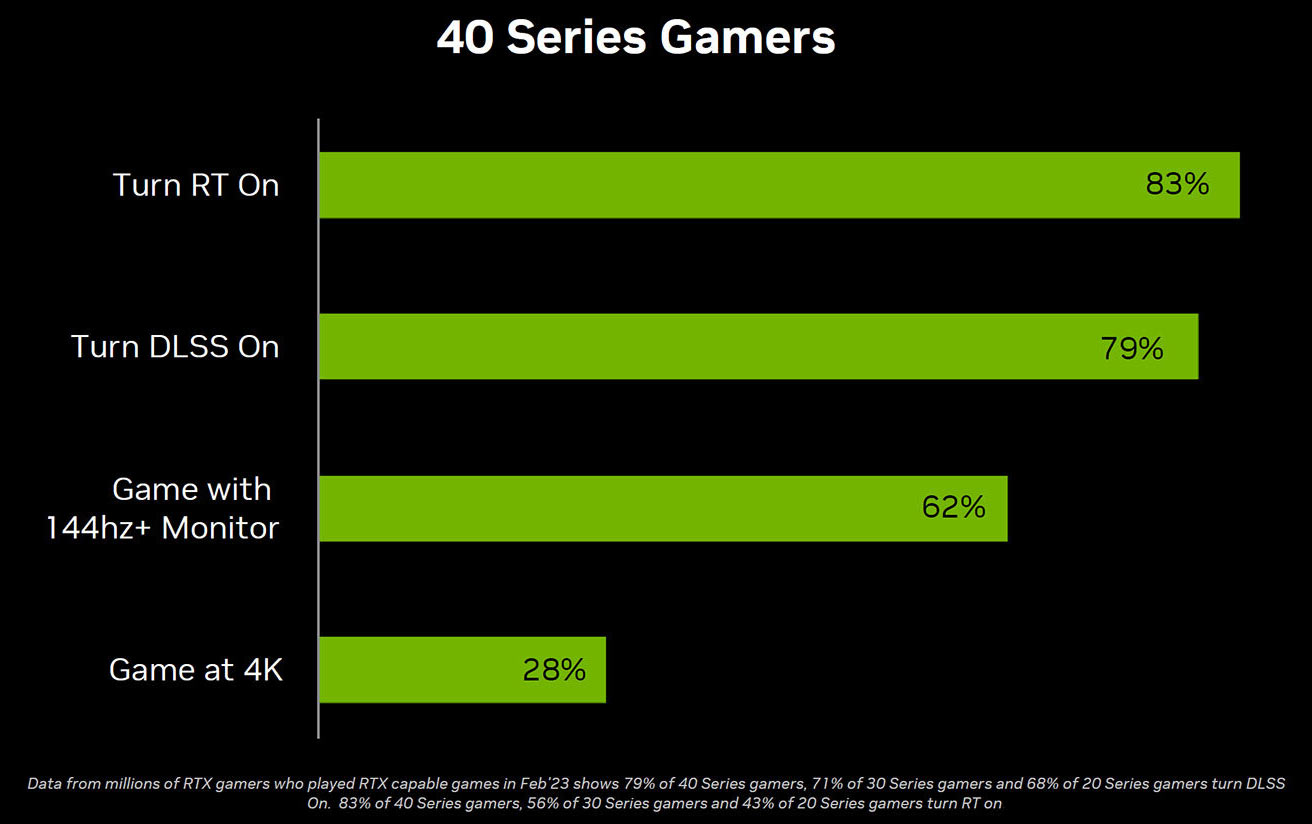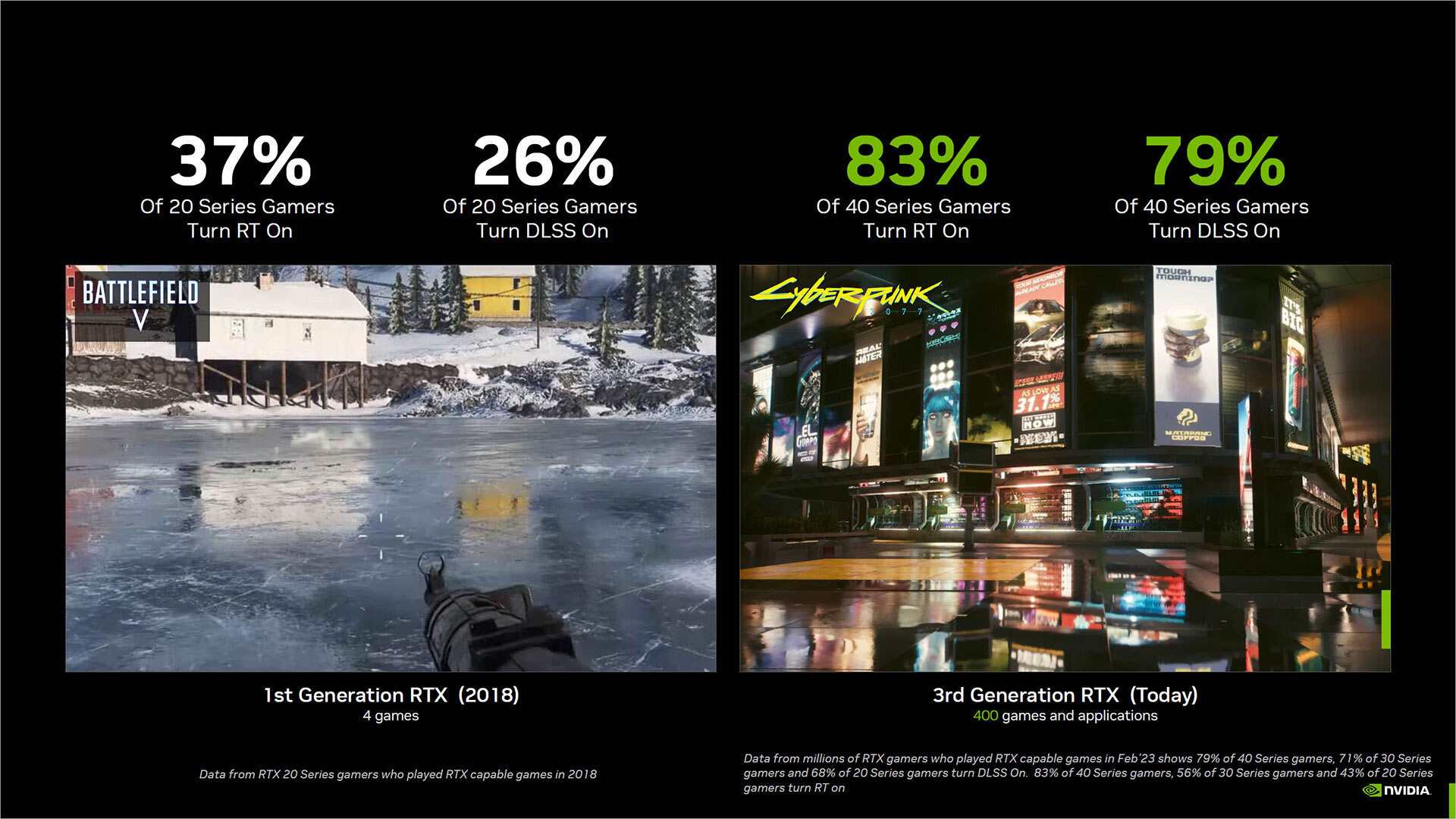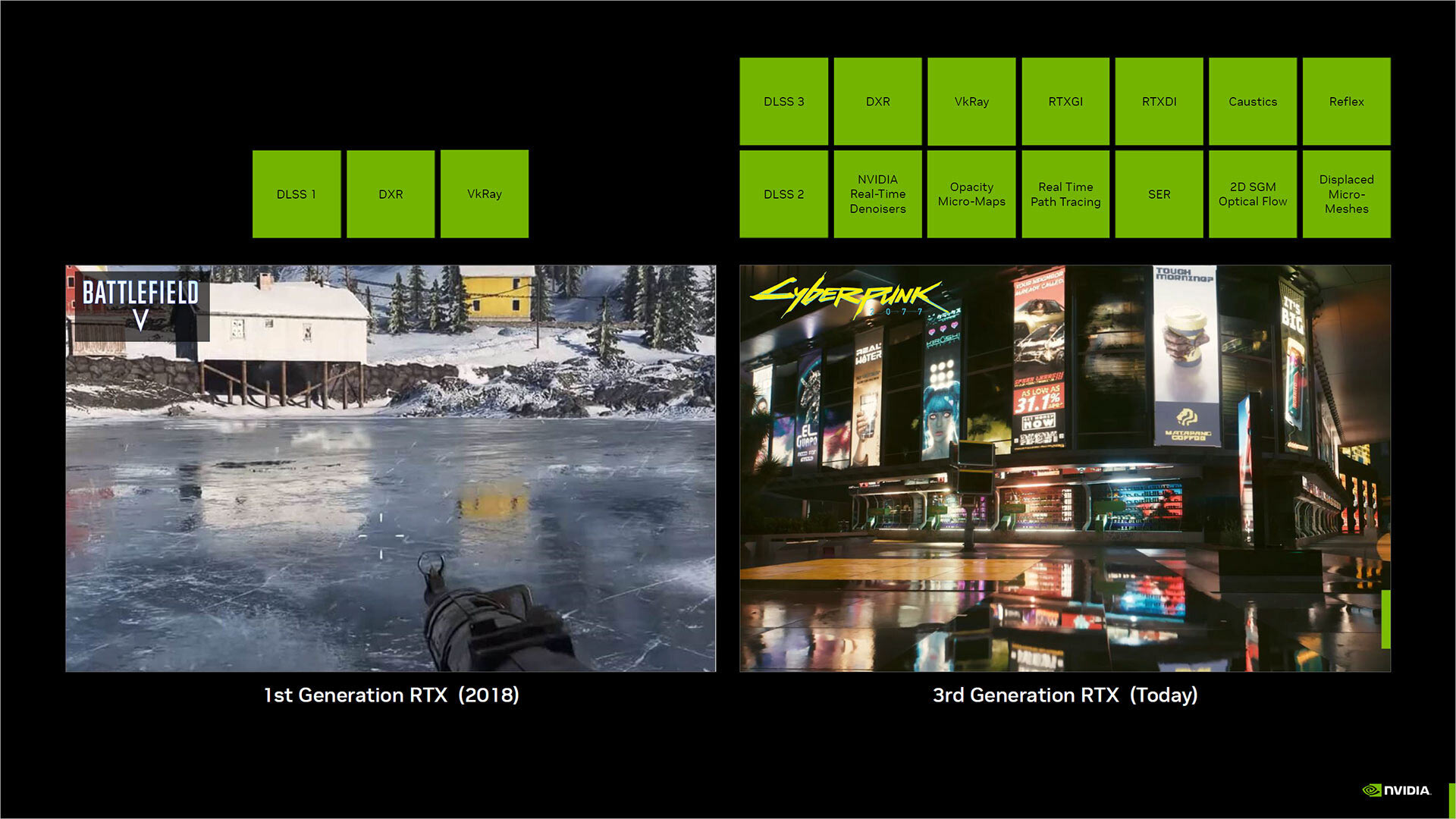RTX On: Nvidia Data Shows Surprising Amount of Gamers Use Ray Tracing, DLSS
Even among RTX 20 users, Nvidia says 43% play games with RTX On.
Do you own an Nvidia RTX graphics card, yet seldom dabble in the ray traced realms that have been promited by the green team for the last four and a half years? If so you are in the minority, according to figures released by Nvidia during the GeForce RTX 4070 launch yesterday. Moreover, it suggests that the newer your RTX GPU, the the more likely that you are to flick the RTX On switch – and the same is true for making use of DLSS upscaling / frame generation tech.
Above, you can see Nvidia’s figures for RTX On and DLSS usage across the three generations equipped with the necessary cores (RT cores and Tensor cores, respectively) to accelerate these features. It shows that initially RTX On and DLSS On were much less popular during the reign of Nvidia's Turing architecture than in 2023 (left side image). Be aware that the February 2023 RTX 20 and RTX 30 figures are in tiny small print beneath the RTX 40 headline (and right side image), so our table helps show the clear intergenerational trend. All this data is harvested by Nvidia via its GeForce Experience software, so won’t include everyone using those GPUs.
| GeForce Series | RTX On in 2023 | DLSS On in 2023 |
|---|---|---|
|
RTX 20 |
37% |
68% |
|
RTX 30 |
56% |
71% |
|
RTX 40 |
83% |
79% |
It is understandable why RTX On is less popular on the first generation of graphics cards that support real-time ray tracing in hardware. The RTX 20 (Turing architecture) GPUs were even broadly complained about at the time for poor performance for little visual splendor. DLSS would come later, and mature to be much more appealing a few years after initial RTX 20 launch. Nowadays DLSS helps make the aging RTX 20 series feel more sprightly.
Elsewhere on the slide, Nvidia crows that from a first gen launch of just four RTX On titles in 2018, the number of games and apps now supporting this real-time ray tracing technology has climbed to 400. That isn’t all, the portfolio of RT core, Tensor core, and CUDA core accelerated graphical features has grown immensely too.
The final new slide provides a closer look at the usage of the newest RTX 40 Ada Lovelace architecture graphics cards. This shows that RTX On is a majorly popular option, and it is almost matched by players turning on DLSS. Remember that only high-end RTX 40 cards had been released at the time of the survey. We are only just getting into the mid-range with the release of the RTX 4070 yesterday.

People buying the top-end RTX 40 cards that have been available so far won’t want to just make do with graphical features turned off – after their heavy hardware investment. You don't spend a ton on a graphics card not to use everything it offers.
One thing which isn’t very clear in the figures is how the GeForce Experience counts a user as one who has turned RTX On and DLSS On. We aren’t sure if you need to be applying these features in all compatible games, or you only have to occasionally dabble to be counted among the positive figures. It is probably best to apply some salt and skepticism to the figures overall, as companies will always positively spin data to 'prove' its technologies are successful.
Get Tom's Hardware's best news and in-depth reviews, straight to your inbox.

Mark Tyson is a news editor at Tom's Hardware. He enjoys covering the full breadth of PC tech; from business and semiconductor design to products approaching the edge of reason.
-
tennis2 ReplyOne thing which isn’t very clear in the figures is how the GeForce Experience counts a user as one who has turned RTX On and DLSS On. We aren’t sure if you need to be applying these features in all compatible games, or you only have to occasionally dabble to be counted among the positive figures. It is probably best to apply some salt and skepticism to the figures overall, as companies will always positively spin data to 'prove' its technologies are successful.
Key point right there. Thanks for making it.
I also wondered how many games apply RT and DLSS automatically when compatible GPU is detected. My gut feeling is that these features would mostly be manual opt-in, but who knows... -
Giroro Where did these slides come from? It must be missing context, because otherwise these 3 slides would be some of most cherrypicked and wildly misleading non-information that Nvidia has ever put out. Maybe theres a lot of extra footnotes or Nvidia put out some actual data, but I can't find it.Reply
Things that badly need clarification:
How does Nvidia define "RTX gamers" and "RTX capable games"?
How does Nvidia define "RTX" and "RTX On", because they are coming across as contradictory.
Which specific RTX technologies are being counted as "RT"
Does "RT" exclusively mean Ray Tracing, because RTX definitely does not exclusively mean Ray Tracing.
As far as I am aware and if nothing changed, "RTX On" Means to enable any of the RTX portfolio of technologies, Which collectively includes both Ray Tracing and DLSS, as well as other stuff. Basically, anything on this slide:
So with that definition of "RTX", a claim of 400 "RTX" games/apps would be a claim that 400 pieces of software can one or more of the features of the RTX portfolio (for games that's usually DLSS, and usually not RT), but I'm sure Nvidia would be very happy for a journalist to misread that claim and tell everybody "400 games feature real-time ray tracing".
But what we do know is that Nvidia isn't saying "Even among RTX 20 users, Nvidia says 43% play games with RTX On."
What they said is "Data from Millions of RTX Gamers who played RTX capable games in Feb'23 shows ... 43% of 20 series gamers turn RT on". There is a LOT of different ways to interpret this statement.
It's clear to me that they want people to think millions of people are regularly turning on Ray Tracing (on Nvidia hardware) and leaving it on long enough to play a game. But I do not think that is anywhere close to the right interpretation, because there are too many qualifiers for that to be the actual claim. This is why much more context is needed.
What I do know for sure is that "RT" and "RTX" are not the same thing, at least not in previous News-Marketing from Nvidia.
Where things are coming across as contradictory is due to the fact that the majority of RTX games do not have Ray Tracing (~127 RT games as of December 22).
There's a chance that Nvidia's definition of RT includes PC gamers using Ray Tracing on AMD hardware, or console games with Ray Tracing features (also AMD hardware). There's no way to know until they define it.
Another way to read these slides at face value, is that it looks like Nvidia is saying that 79% of their high-end 40 Series owners need DLSS upscaling. Which is funny to think about but probably not true. -
lmcnabney Curious what the data really is.Reply
For the RTX40 cards the chart shows 83% 'Turn RT On'.
Does that mean that 83% of the time that those RTX cards are running they are RT or does it mean that they have turned RT on in at least one game for at least one minute? Nvidia can make statistics say almost anything. -
Jagar123 Reply
Yeah, this all reads like marketing slides. I don't buy any of it. I don't know many people personally, or online that use ray tracing in their daily games.lmcnabney said:Curious what the data really is.
For the RTX40 cards the chart shows 83% 'Turn RT On'.
Does that mean that 83% of the time that those RTX cards are running they are RT or does it mean that they have turned RT on in at least one game for at least one minute? Nvidia can make statistics say almost anything. -
hotaru251 I can say most users don't install that Experience software (its so bloated) so take the data with massive amount of salt.Reply -
bigdragon The 28% figure for gamers using 4K surprises me. I expected that number to be half as high. PC monitor makers seemed to be allergic to the idea of 4K for the longest time.Reply
I don't find the RTX figures to be anywhere near as surprising. The tech has come a long way since it's weak rollout years ago. Implementing some variant of RT has become as easy as clicking a button in some game engines. -
mrv_co Makes sense that someone buying an expensive GPU with a much hyped feature would try it out at least once. And maybe even try it on each game that supports it. The question remains, what % of those folks leave it on and how does that vary by game?Reply -
BaRoMeTrIc This truly is surprising , considering ray tracing is enabled by default on most aaa games these days, along with dlss if youre using 1440p/4kReply -
usernamist 40 series card owners are people who spent over a 1000 bucks on this gimmick, of course they're going to try it. How is anyone surprised by this?Reply -
KyaraM Reply
Did you follow any hardware news at all this year? Neither the 4070 nor the 4070Ti costs 1k... and both can indeed do RT and any other tech covered under RTX.usernamist said:40 series card owners are people who spent over a 1000 bucks on this gimmick, of course they're going to try it. How is anyone surprised by this?
About thise slides, they need the same amount of salt applied as any benchmark slides or other marketing slides put out by any company. Personally I think it's "uses any of these features"; though most games only let you choose RT or DLSS, some may let you choose to enable Reflex (eg. Hogwarts Legacy) separately. The other stuff sounds like something that will be turned on in the background when RTX is enable, buth which the user doesn't directly interfere. It's probably not even there in all games.

